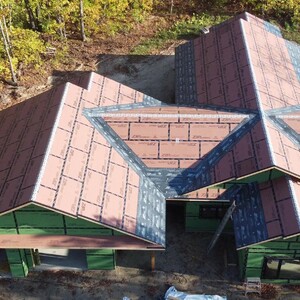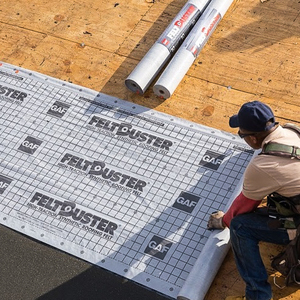Rarely do builders go back months or years after building a home to see how the assemblies are holding up. It’s not until a disaster strikes that the details get tested. This month a large tree fell across the roof on the house where we photographed the Fine Homebuilding article “9 Upgrades to Windproof Your Roof” for the March 2019 issue. To make repairs, we had to cut away all the roof sheathing covering the hip rafter and jacks back to the second common rafter. By removing over 24 ft. of eave edge, we were able to see how well the sandwich worked that we layered up last June to hold the first course of shingles tight to the roof deck.
The drip edge was nailed down at 4 in. oc with every third nail driven into the roof rafters. The ice barrier membrane was bonded to the top 1-1/2-in., and a 12-in. layer of Protecto Wrap Roof Edge Seal double-sided bonding/flashing membrane was adhered over the exposed flashing and ice barrier. The starter row of shingles was set flush with the bottom of the drip edge and adhered to the Roof Edge Seal. Nails were driven 2 in. up from the edge to mechanically hold the starters in place. Finally, the first course of shingles was placed flush with the drip edge and sealed to the starter strip via the self-seal strip.
I tried to peel the drip edge off the roof sheathing when removing the sheathing panels from the broken jack rafters but it wouldn’t budge. We ended up cutting through the drip edge and shingles to get the panels off the roof. I picked at the layers of flashing and roofing with a flat bar to see how tight everything was bonded. The adhesive bond between the drip edge, Roof Edge Seal, and starter strip was so strong that the starter shingle shredded apart, exposing the fiberglass base mat. And the self-seal strips between the starter and first course of shingles bonded just as well, leading to shingle shredding when I tried to separate them.
The roof has only been in place for nine months, so it’s hard to know if the adhesive bonds will be as strong 35-40 years from now, when the roof is ready for replacement again. My hope is it will stand up to the hurricanes and gales that our area is prone to from time to time.
_________________________________________________________________________
Mike Guertin is editorial advisor at Fine Homebuilding magazine. He has been a builder of new homes and remodeler of old ones for over 35 years. Find Mike at @mike_guertin and www.mikeguertin.com.
Weekly Newsletter
Get building science and energy efficiency advice, plus special offers, in your inbox.















0 Comments
Log in or create an account to post a comment.
Sign up Log in